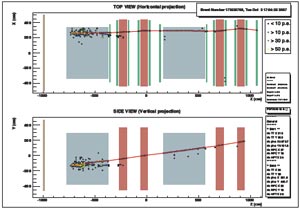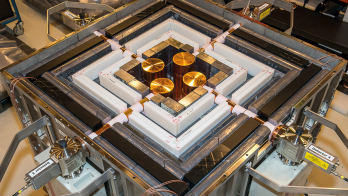The first neutrino event of the 2007 run of the CERN Neutrinos Gran Sasso (CNGS) facility was recorded on 2 October, when one of the many millions of neutrinos in the beam from CERN interacted in the OPERA detector in the Gran Sasso National Laboratory, 730 km away in Italy. The interaction occurred in one of nearly 60,000 “bricks” already installed in the detector and provided the first detailed event image in high-precision emulsion.

Image credit: OPERA.
There is now plenty of evidence that neutrinos oscillate between three “flavour” states, associated with the charged leptons: electron, muon and τ. Several experiments have observed the disappearance of the initial neutrino flavour but “direct appearance” of a different flavour remains a major missing piece of the puzzle. The CNGS beam consists of muon-neutrinos, and the observation in OPERA of a few τ-neutrino interactions among many muon-neutrino events will provide the long-awaited proof of neutrino oscillation.
In 2006, OPERA collected about 300 neutrino events during the commissioning run of the CNGS facility (Acquafredda et al. 2006). However, these did not include information about the event-vertex recorded in the thousands of small “bricks”, each made of a sandwich of lead plates and nuclear emulsion films, which make up the “heart” of OPERA. The emulsion technique allows the collaboration to measure the neutrino interaction vertices with high precision. Installation of the bricks continues daily and the total is nearing the halfway mark, ultimately reaching 150,000 bricks with a total mass of 1300 tonnes.

Image credit: OPERA.
The event of 2 October was the first to be registered in a brick, and some 37 more events occurred in the following days. An automated system immediately removed the bricks containing these events from the detector. They were then dispatched to the various laboratories of the OPERA collaboration, which are equipped with the automatic microscopes required to scan the emulsion films and make relevant measurements. Figure 2 shows the microscope display for one of these events, representing a volume of only a few cubic millimetres but rich in valuable information for the OPERA physicists.
This is a crucial milestone in an enterprise that started about 10 years ago. The OPERA detector was designed and realized by a large team of researchers from all over the world (Belgium, Bulgaria, Croatia, France, Germany, Israel, Italy, Japan, Korea, Russia, Switzerland, Tunisia and Turkey), with strong support from CERN, INFN, Japan and the main European funding agencies. Numerous hi-tech industrial companies were also involved in the supply of the many parts of the equipment necessary for building the large detector.
Further reading
R Acquafredda et al. 2006 New J. Phys. 8 303.








